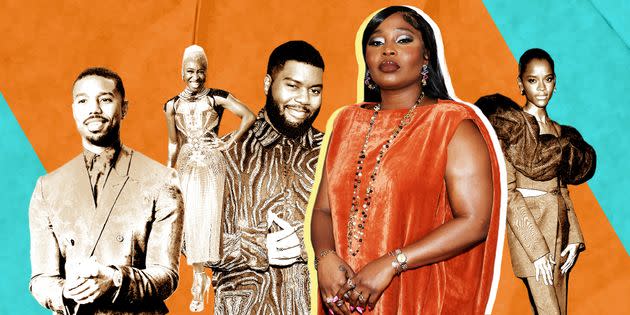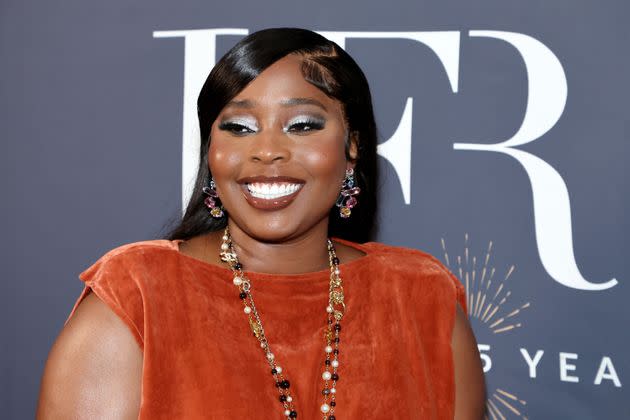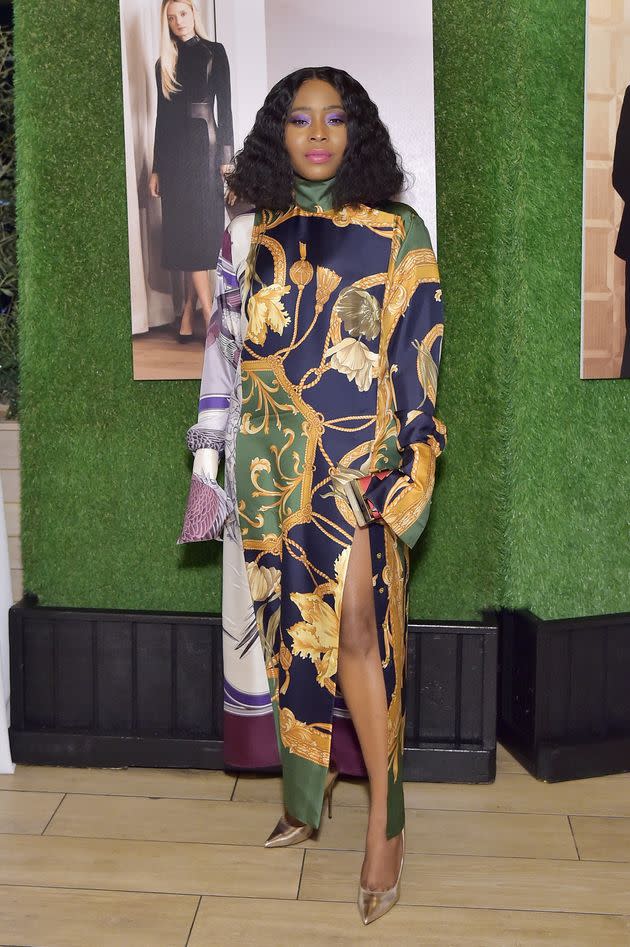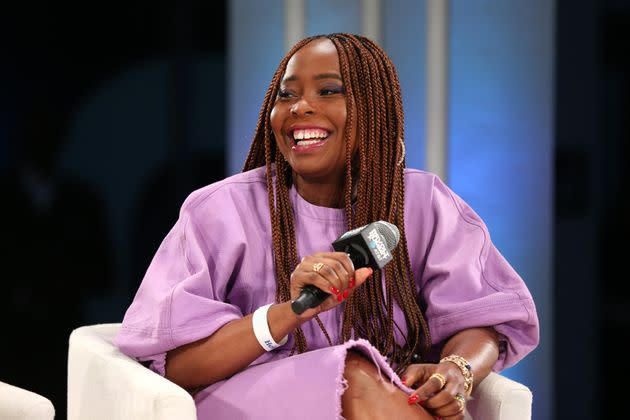This Celebrity Stylist Combines New York Grit With Her African Roots
- Oops!Something went wrong.Please try again later.
- Oops!Something went wrong.Please try again later.
- Oops!Something went wrong.Please try again later.

From being a fashion assistant at Teen Vogue to winning awards from Harlem's Fashion Row, Ade Samuel has made a name for herself dressing today's stars.
The glitz and glamour of entertainment is nothing without the people who dress today’s biggest stars. For “Who’s Behind the Clothes,” HuffPost spotlights stylists and costume designers who have delivered some of our favorite celebrities’ or characters’ most memorable looks.
No matter how far Ade Samuel travels from home, it’s always with her. Raised in the Bronx, the Nigerian New Yorker has made a name for herself as a Los Angeles celebrity stylist. With over 14 years in the game, Samuel has not only dressed Letitia Wright, Michael B. Jordan, Khalid and more stars for the red carpet, but has also styled Beyoncé’s “Formation” music video.
Before she was named Harlem’s Fashion Row Stylist of the Year in September, Samuel got her start sewing alongside the matriarchs in her family, notably her grandmother. During her junior year of college, she was an assistant to Fern Mallis, the creator of the modern New York Fashion Week, before pursuing public relations upon graduating.
“Then, [I] graduated to work in PR at Trachtenberg & Co. then doing some internships with magazines at Condé Nast. I was at W Magazine first, then Teen Vogue,” Samuel said. “That was my pivotal job after college, which was really amazing because being at Teen Vogue, I got to learn what the career of a stylist was, which wasn’t something I knew. I kind of dived into different areas.”
After being a fashion assistant at Teen Vogue for three years, she left New York and headed west to Los Angeles. Known for her bright colors, patterns and innovative prints, Samuel combines her New York grit with her African roots to carve her own unique approach to styling.
“I always say that the doors for Black women stylists could not have been opened without people like Patti Wilson, June Ambrose, and Misa Hylton,” she said. “Those were the pioneering women that were super influential to me and what I wanted to do.”
For HuffPost’s “Who’s Behind the Clothes,” Samuel reflected on her career, style and favorite outfits, the tenets that are central to her work, and what it means to champion Black creatives on the African continent.

Ade Samuel attends Harlem's Fashion Row 15th-anniversary Fashion Show and Style Awards on Sept. 6 in New York City.
What was it like working for Fern Mallis?
It was amazing. I like to be very honest: Being a girl from New York, specifically from the Bronx, I wasn’t aware of the who’s who in the fashion industry. I think a lot of my opportunities came from just hard work and just really soaking in the experiences. With Fern, it was an internship that I got to be her right hand during fashion week, and really work with the different designers to make sure that her seat was available. It was a very intern, apprentice-like position. But what was interesting was that I didn’t really take away a lot from the experience. It wasn’t good or bad. It was just more of like, “OK, this is an area of fashion,” like that was how I kind of soaked it in in the beginning of my career not really knowing or having the opportunities or privilege to work in a space where I knew the who’s who. I wasn’t privy to that; I just really wanted to do fashion. It was just a calling for me.
Being a New York native, what did it mean to you to win Harlem’s Fashion Row Stylist of the Year recently?
That was a dream. I was so grateful to receive that award and it was such a surreal moment, because it was also my birthday. It always feels good when you’re seen, especially as a Black woman in this business. It’s really a very beautiful feeling when people respect and can give you flowers for your work. We know in our culture, especially being a Black woman, we have to work double time. When you have an organization like Harlem Fashion Row that really supports our community, giving you your flowers, it is just magical.
How did your upbringing in a Nigerian household in the Bronx inform your career and style?
Being of African descent and being from New York City, style and fashion is a huge part of our culture. People organically and authentically have their own vision for themselves, their own style, their own kind of cool. I think that that is literally what makes people from New York the most fashionable. For people from Africa, I think fashion just has played a pivotal role in our cultures and traditions, whether it’s a wedding, a funeral, a celebration or a party. You have to always design your garment, which really was an element of something that my grandma did and taught me about. Seeing that also influenced me, like, “OK, there’s different ways to express yourself as a fashion lover,” or even just through your culture. I think that’s what’s really influenced what I do; just the ability to implement colors and prints and play with different elements and silhouettes.

Ade Samuel attends The Hollywood Reporter and Jimmy Choo Power Stylists Dinner on March 12, 2019, in Beverly Hills, California.
Who are the people that instilled your love for style?
My grandma was really, really a pivotal person, because she was a tailor for the community. She would take [garments] for different events that my parents had or different events that my cousins had, and really create these outfits with fabrics and patterns. She really taught me how to pattern-make with your eye; most people go to school for that, but she just knew how to eyeball from experience. She really was the first person to show me what fashion could become, and how it was an art form. It wasn’t just like, “Oh, I’m going to shop today,” or “I’m going to look at this specific lace.” She really taught me the importance of making sure that it was comfortable [on] the body of the person that we were putting it on — but really playing with the different silhouettes that I don’t think was imaginable for me as a young child. I was buying what was popular at the time or something like that, but then she would show me a billowy T-shirt with this exaggerated shoulder and I’m like, “Oh, my God, this is amazing.” I think her creative eye and flow was really an inspiration in the way that I style.
You did an interview with the LA Times talking about the art of dressing, and said that having good music was really important to you. Do you have a ritual before you style clients?
A part of the importance of styling is really, honestly, just doing a lot of research for the clients. Playing good music is probably the one thing that’s consistent in what I do. But there’s days when I’m driving to the client’s house — because I live in LA and I drive so often — and I drive in silence, just to get clarity on my thoughts on what my day is like. As a stylist, our day is so different every day. I try to just maintain the consistency and think, how do I style someone that maybe I haven’t worked with before? Research is a big part of being inspired for me and getting an idea on what would work, what wouldn’t work.
What are the style principles you hold dear, be it comfort or versatility, and what do you hope people glean from your practice?
One of my principles is being collaborative. I really think it’s important to amplify your client and your project with what feels natural for them, but also is maybe a step up. Another would honestly be just really having knowledge. Research is a great word, but really having knowledge of the different designers and knowing how to expand outside of just what’s most known or most, most popular. A lot of times when you work with me, my clients get to really expand and have fun with new designers and designers that are from different cultures. That’s one of the pivotal things that I like to do. Another principle is to have fun. We’re not saving lives; we’re stylists. I think that’s something that I lean toward when I’m working, especially with my team or just working with a new client. It’s like playing dress up with an expert.

"My grandma was … a tailor for the community. She really taught me how to pattern-make with your eye. ... She really was the first person to show me what fashion could become, and how it was an art form," said Samuel.
On average, how long does research take?
Sometimes, we have 24 to 48 hours. Sometimes, we have a month or two weeks. It really just depends on the client. I will say a daily practice that I try to have is looking at magazines, holding the physical magazines, going through the pages, going to art galleries, and utilizing social media to get inspired. I think being inspirational is really just the key to figuring out what I want to do, and if I practice that every day, then it becomes normal. So when a job comes — and a lot of times, our turnovers are so fast — I already have things kind of Pinterested and have collected ideas that I’d like to explore.
Well, how do you work with so many different types of celebrities to get a desired result? How do you balance their various needs, while not caving into cyclical fashion trends?
I just try to figure out who they are by having conversations with them and diving into each of my clients. When I meet them, I really take who they are and just amplify it, whether it’s a creative vision that I have and that maybe we discuss. Every individual client, I go into with a different mentality: Let me see who they are, let me see what they like, what they don’t like, and then I tailor what I do to accommodate that and make them comfortable as well. What we do is a collaborative process.
People often cite and remember the “embroidered bib” from Louis Vuitton that you styled Michael B. Jordan in — but recently, you styled Jhené Aiko in an outfit that was later animated on Kid Cudi’s “Entergalatic.”
That was cool. I respect Virgil so much and I’m a huge Cudi fan, so to have my look animated was really, really just an amazing thing. Virgil was just so supportive to a lot of creatives within our community. I just found that to be dope.
Apart from the “bib,” is there a particular style or particular outfit that you’ve dressed someone in that resonates with you as of late?
This year, the most popular look was the one I did with Letitia from Fendi for Cannes. I think people really resonated with that milky brown jacket from Fendi, and the color pop that existed. With Letitia, I love to play on a really tailored kind of aesthetic for her. I think that was the one that stood out to me the most.
From previous interviews, you talked about the importance of platforming African designers, especially in the short film you created. Can you tell me a little bit about why that’s important to you in your work, and where you see the future of African fashion going?
I think Africa is the future. We know that, period. Being my culture and my home, I just think that it is important to support and be a part of what’s happening in the creative spaces. What I did with Essence was just an homage to home, to my country, to the motherland. That’s just because authentically, what I resonate with as an African girl, is those people, those creatives in the industry. What they’re doing at home is just fantastic; between the art, the music, the amplification, and just really bridging that gap is just something that I want to be a part of, with everyone that’s doing that in the African space.
On the note of supporting Black creatives, tell me about your collaboration with IN THE BLK in 2020.
IN THE BLK is actually a Victor Glemaud company, so we are just all members. I would describe it more of just a community of members who were really passionate during that time. I’ve known Victor for years and some of the people in our group as well. That [collaboration] was a part of the expansion of creative production and creative direction as well. In the height of everyone being passionate about Black creatives and artists and really seeing them and giving them their flowers, I was so honored to be a part of what creative production did with IN THE BLK. It just felt good to be a part of that community and work with my peers and creatives to just show what we can do and do it from a place of art instead of the limitations that sometimes happen when you’re working in corporate spaces or certain clients or projects.
Where do you see your career going? You’ve done celebrity styling, shoe designing and more — what do you hope to do next?
I’m diving more into that visual production, you know, what I did with Essence, and what I did with the City Girls for Coachella, and the creative direction space is really what you’ll see more going into the new year. Collaborations with brands similar to what I did with Macy’s is something that I look to continue to do going into the next few years. Just amplifying that.
How have you seen your personal style evolve through the years, and how would you describe it? Who do you gravitate towards?
I would say my style is super eclectic and inspired by color. For me, color story, having that kind of push on print, being bold and eccentric is how I’d describe myself. But I think where fashion is going for me is just a bit more minimalist, just trying to not really create an aesthetic but live with this concept of what is necessary presently. For me, being a stylist, one of the evolutions of where I am versus where I was, COVID really helped everyone to have that bit more grounded experience in what we’re doing. I do see myself growing into more of a more minimalist space, not necessarily in the way that I’m dressing, but just more in my approach to work.
What’s the biggest lesson that you’ve learned so far? What would you say to a young Black girl in the Bronx who wants to do this?
My biggest lesson that I would say is really soak it in. Soak in what you’re doing, be present, but also understand that you have to be consistent. I say that, because I think we’re living in such a fast-paced, digital society and era now that we weren’t living in when I was doing this. I often find that everyone wants to get to the now now. I found that for me, one of my successes is that people saw that in what I was doing, people saw the perseverance, people saw how creative I was, and how serious I was to learn from them. Because of that, the network is your net worth; people will push for you when they know that you’re a hard worker. In my decade of doing this, and also experiencing so many assistants and amazing creatives who are now even doing big things, consistent perseverance was really what helped them and just being knowledgeable as well.
Related...
How 'The Woman King' Costume Designer Creates New Worlds Through Clothing
How Colleen Morris-Glennon Made Sure 'Industry' Characters Looked Wealthy Enough
How Tiffany Hasbourne Elevated Southern Style On Donald Glover's 'Atlanta'
How Lucky Daye's Stylist Problem-Solves For Today's Biggest Emerging Stars
